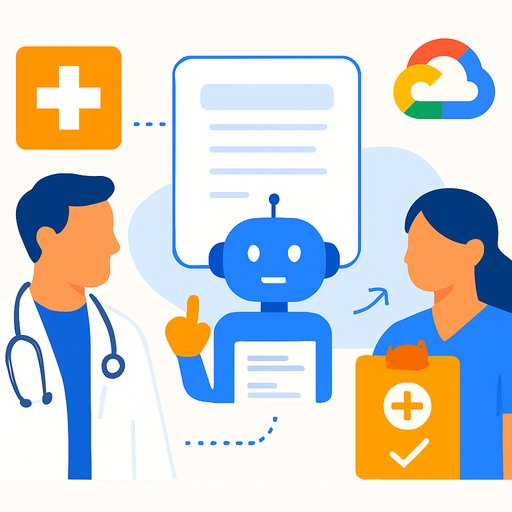Google Cloud unveils new health AI agent partnerships
Google Cloud announced multiple healthcare partnerships focused on AI agents that summarize clinical notes, streamline prior authorization and guide preventive care. The move reflects broader adoption: In a Google Cloud survey of 605 leaders, 44% said their organizations are using AI agents, and 34% reported using 10 or more.
For health leaders, the signal is clear. AI agents are shifting from pilots to production, with measurable impact on clinician time, documentation and throughput.
Hackensack Meridian Health: Summaries that fit the specialty
Hackensack Meridian Health built several agents using Google's generative AI, including a tool that summarizes patients' medical records for clinicians. Since going live in June, more than 1,200 clinicians have generated over 17,000 summaries.
The summaries are now specialty-aware. An oncologist sees different, more relevant highlights than a urologist, according to Sameer Sethi, SVP and chief AI officer at Hackensack Meridian Health. The goal: reduce time spent scrolling through charts and free up attention for patients.
The system is also rolling out two additional agents: a Neonatal ICU assistant that surfaces best practices and policies for nurses, and a lab results summarizer that helps primary care clinicians draft patient updates faster.
IKS Health: Automating prior authorization with a human-in-the-loop
Google Cloud partnered with IKS Health on a multi-agent platform that flags when prior authorization is likely required and manages the process. The stack includes a documentation assistant for visit notes, a coding agent that aligns documentation and billing codes, and a prior auth agent that works with payer systems to gather the needed administrative and clinical data.
A human reviewer validates outputs where medical necessity is involved. This supports accuracy while reducing manual back-and-forth and delays.
Color Health: Guiding breast cancer screening
Google also announced a partnership with Color Health to launch an AI assistant that helps women determine breast cancer screening eligibility and schedule care. For clinical teams, this can help route patients to the right setting sooner and reduce missed screenings.
For reference, current independent guidelines are available from the U.S. Preventive Services Task Force. See breast cancer screening recommendations here.
Why this matters for care delivery and operations
Note summarization can cut cognitive load and reduce time-on-screen, especially for complex histories. Specialty-aware outputs increase relevance and trust.
Prior authorization remains a significant administrative burden. Automation that integrates with payer systems can shorten cycle times and improve patient access, especially as regulators push for faster electronic prior auth responses. See CMS' Interoperability and Prior Authorization rule summary here.
What healthcare leaders should do now
- Identify high-friction workflows: chart review, discharge summaries, prior auth, and patient messaging.
- Pilot specialty-aware summarization in one service line with clear guardrails and success metrics.
- Stand up a clinical and data governance group to approve use cases, prompts and redlines.
- Plan for human oversight in any decision that affects medical necessity, coding or patient safety.
- Integrate with EHR and payer APIs early; ensure audit trails and version control for every AI action.
Key questions to ask vendors
- What data is used for training and inference? How is PHI isolated, encrypted and logged?
- Can outputs be specialty-tuned and aligned to our documentation templates?
- What is the measurable reduction in clinician time per note or per chart review?
- How do you handle hallucinations, uncertainty and provenance? Are citations included?
- What prior auth coverage exists across our top payers and service lines?
- How are human-in-the-loop checkpoints configured and audited?
Metrics to track from day one
- Clinician time saved per encounter and per week.
- Note quality: completeness, accuracy and downstream coding edits.
- Prior auth cycle time, approval rates and denial reversal rates.
- Patient throughput for targeted service lines.
- Safety signals: overrides, escalations and error rates.
- User adoption and satisfaction by role (physician, nurse, coder).
Risk management and safeguards
- Use least-privilege access to PHI; encrypt in transit and at rest; log every request and response.
- Provide clinicians with clear controls to accept, edit or reject AI output.
- Establish prompt libraries and blocked prompts for sensitive scenarios.
- Run bias and drift monitoring, especially for specialty summaries and triage.
- Maintain legal and compliance review for payer-facing submissions.
Upskilling your team
Adoption improves when clinicians and operations staff know how to work with AI agents, review outputs and escalate issues. For structured training on AI tools and workflows, explore curated options by role here.
The bottom line: AI agents are moving into core workflows. Focus on high-impact use cases, tight EHR and payer integration, and measurable outcomes with strong oversight.
Your membership also unlocks:






